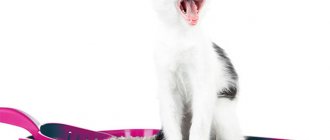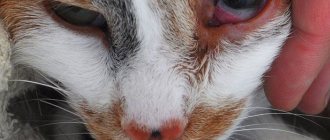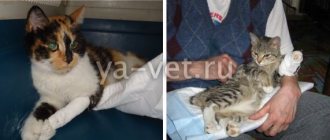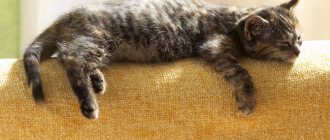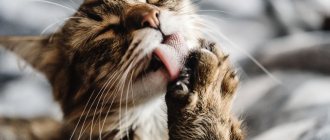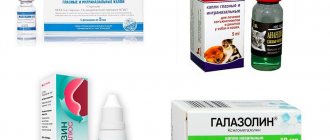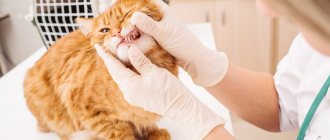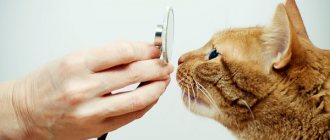The position when the lower jaw protrudes in front of the upper jaw, the front teeth do not touch each other, is called an overbite. If the undershot is slight, then outwardly it manifests itself as a pronounced chin, which is rather a plus for some breeds. A severe undershot is manifested by the fact that the lower teeth are visible when the mouth is closed, almost like a bulldog.
Underbite is less common and manifests itself in the fact that the upper jaw is longer than the lower jaw. As a rule, even in this case, the pathology concerns the lower jaw: it lags behind or is prematurely inhibited in development.
Alas, in case of overbite or underbite, treatment and preventive measures are pointless. Some breeders recommend massage of the lower jaw in case of underbite in a kitten, but there is no reliable information about the effectiveness of this method.
A misaligned, or lopsided mouth, develops when one side of the jaw grows unevenly. This pathology is more common in Persian, exotic, and less common in British, Siberian and other breeds of cats. Often, having arisen in a kitten, this pathology disappears on its own when teeth change. However, sometimes baby teeth that do not change for a long time can themselves begin to interfere with the restoration of the correct geometry of the jaw.
What to do? If the distortion does not interfere with your animal’s life, do nothing. Firstly, the pathology can go away on its own with age, and secondly, as a rule, it does not interfere with the cat’s life.
If you still intend to participate in exhibitions, it is recommended to chop off the fangs on each side of kittens under the age of 2 months. The jaws become more mobile, and there is a high probability that when changing teeth, the bite will become correct. But such operations should be carried out only on the recommendation and under the strict supervision of a veterinarian.
The bite in cats is the position where the teeth of the upper and lower jaws meet. The bite is an important parameter when choosing a kitten, because if it is a purebred animal and the cat has an incorrect bite, in the future it may be disqualified due to this defect and not allowed for further breeding. And even if this is a domestic cat with an incorrect bite, he may also experience some discomfort, suffer from dental diseases, etc. due to the characteristics of changes and deviations from the norm. I would also like to note that a cat’s bite can change over the course of their life.
The structure of the jaw and the number of teeth in cats are the same and do not depend on the breed or outbred.
Malocclusion
As cats grow, their jaws begin to change. Sometimes the body gives surprises. This applies to cases when the baby incisors are in no hurry to fall out. This disorder leads to improper growth of molars. The process does not happen as it should, but in different directions. As a result, this appears:
- underbite is when the upper jaw protrudes slightly forward and, when closing the mouth, overlaps the lower incisors without touching them;
- undershot is a protrusion of the lower jaw forward, somewhat reminiscent of a bulldog's jaw;
- skewed mouth, when the jaws grow unevenly and this makes it very difficult to grab food.
Untimely loss of baby teeth can lead to pathologies such as underbite or overbite.
One of the reasons for the development of the pathologies listed above is the untimely loss of baby teeth. This helps stop normal jaw growth. The breed of the cat does not affect the bite, although it has been confirmed that it is most often incorrect in short-faced breeds. Only kittens can calmly cope with underbite if the deviation is small.
Correct bite in cats
The correct bite in cats - the norm - is considered to be straight pincer-shaped, the teeth are located vertically, the lower canines are located between the upper ones. In purebred cats, minor changes may be allowed due to the characteristics of the breed, for example, shortened (acceptable minimum overshot is up to 2 mm) or elongated (undershot up to 2 mm is also acceptable) muzzles and noses.
Normal bite:
- Pincer-shaped (the teeth are even, do not overlap each other, the incisors close straight together)
Acceptable bites related to the norm:
- Scissor-shaped (the lower canines slightly overlap the lateral incisors, the upper incisors closely overlap the lower ones)
- Overshot or undershot up to 2 mm
Correct bite in a cat: photo
How to recognize problems?
If, upon examination of the animal, an unpleasant odor from the mouth was detected or, when eating, the cat squints strongly, and a cat with an incorrect bite shakes its head violently when stroked on the cheek, then these signs indicate that the pets are developing dental diseases. There are several factors that influence the occurrence of the problem:
- breed specifics;
- metabolic disorder in a cat;
- underbites;
- roughness of tooth enamel;
- non-natural feeding.
Prevention and dental care
Tartar is considered one of the main causes of incisor loss in cats. Next comes caries. To avoid problems, you just need to follow the recommendations:
Proper care, which includes daily brushing, will help you avoid oral problems.
- brush your animal’s teeth every day with special toothpastes;
- include calcium and phosphorus supplements in your diet;
- if necessary, switch the cat to a special food that cleans the incisors of tartar;
- inspect your pet’s mouth daily;
- attend preventive examinations regularly.
Then the animals will not have any problems, the incisors will become healthy, and the bite will be correct. In order to protect your pet from a serious illness, you need to follow basic rules for care and maintenance. It is very important to understand what dental procedures are needed, and your pet will delight you not only with beauty, but also with health.
Bite correction
Treatment methods for malocclusion can be divided into two groups: orthodontic - involves the use of modern devices that can change the position of the teeth, and surgical - changes the length of the jaws through surgery. Before choosing any of the treatment methods, remember that the technique for each case is selected individually. There are many correction methods. Treatment is prescribed depending on the complexity of the pathology, as well as taking into account the qualifications of the specialists who will work with the animal.
Injuries to the cat's face and jaws.
If your cat has broken teeth, it should be taken to a veterinarian to determine whether there has been damage to the pulp. If the fracture involves the pulp, root canal treatment is necessary, and possibly removal of the affected tooth. Wounds in the gums and other soft tissues also need to be treated.
Bone fractures are stabilized by a veterinarian using wires, pins, and other appropriate methods. After treatment, most supporting materials are removed, usually after 6 to 8 weeks. During treatment, if you have difficulty feeding yourself, tube feeding may be used.
Today, owners quite often turn to the veterinary clinic to correct the bite of their pets. The most common patients are dogs of dwarf breeds.
What is malocclusion? What are the types of malocclusion? How common is it in cats and dogs? Is malocclusion in dogs fundamentally different from malocclusion in cats?
A pathological bite is an incorrect relationship between the teeth of the upper and lower jaw. Such a pathology can be caused by an incorrect ratio of the length of the jaws (the lower jaw can be much longer than the upper jaw or severely underdeveloped) or the incorrect location of the teeth themselves on correctly developed jaws.
| Left - Overshot (progenia) as a result of a greatly elongated lower jaw in a Bichon dog. In the center - Underbite (prognathia) as a result of underdevelopment of the lower jaw in a Dachshund dog. Right - Displacement of the canines on the lower jaw to the center of the oral cavity (retroposition) in the Yorkshire Terrier. The lower and upper jaws are developed correctly. |
Let's look at the most common types of bites in dogs:
- A scissor bite (orthognathy) is normal in most dog breeds.
It is characterized by a tight closure of the upper and lower incisors in such a way that the tops of the lower incisors should rest against the base of the upper incisors. The fangs should be in a tight “lock”.
- Overshot (progenia) is the norm for bulldog breeds of dogs.
- Underbite (prognathia) is not normal for any breed of dog.
- Pincers (direct bite). Allowed and considered normal for some dog breeds.
Rice. 5. Underbite in a Yorkshire Terrier. The photo clearly shows that the tops of the lower incisors do not rest against the base of the upper incisors. Rice. 6. Cane Corso has a straight bite. The tops of the incisors rest against each other, the fangs are located in a tight “lock”.
- An open bite (not closing the incisors) is not normal.
- Distortions (asymmetry). Not the norm.
Rice. 7. Skewed Tibetan Mastiff. The left branch of the lower jaw is pushed forward.
Malocclusion occurs predominantly in small and toy breeds of dogs. In large dogs, malocclusion is quite rare, but in cats it is practically never found.
A special feature of bite correction in cats is the ability to manipulate only the positions of the fangs. This is due to the fact that cats have very small incisors, so the possibility of applying orthodontic appliances to them is practically excluded.
On the left, the cat’s canine is shifted to the center of the upper jaw. On the right, an orthodontic structure was applied to the canine, which moved the canine to the correct position.
What are the consequences of living with a malocclusion? How serious can they be for a pet? An incorrect bite can have serious consequences for your pet. There are situations when a displaced canine leads to the formation of an oronosal fistula (a hole in the palate between the oral and nasal cavities) or to incomplete closure of the jaws, which, in turn, causes the formation of plaque and then tartar.
Rice. 9. Underbite and retroposition of the lower canines in a one-year-old bobtail dog. Tartar.
There are situations when the malocclusion is only a cosmetic defect, then there are no medical indications for its correction, and its correction is carried out only at the request of the owner.
How is a bite usually corrected? How long can treatment take? What does the doctor do and what should you do at home (if necessary)?
There are a huge number of methods for correcting bites, so in each specific case the choice depends on the conditions of the malocclusion itself and on the doctor’s knowledge of one or another technique for correcting the bite.
Conventionally, methods for correcting bites can be divided into two groups: orthodontic and surgical.
The orthodontic method of correction involves the use of a huge variety of different orthodontic devices, which is aimed at changing the position of the teeth. The surgical method is used to change the length of the jaws.
| Rice. 10. Options for orthodontic structures. | Rice. 11. Options for orthodontic structures. | Rice. 12 a. Vestiposition (disposition of the tooth crown towards the vestibule of the oral cavity) of the canines in a Pomeranian Spitz. Against this background, a change in the position of the extreme upper incisors occurred. | Rice. 12 b. Vestiposition (disposition of the tooth crown towards the vestibule of the oral cavity) of the canines in a Pomeranian Spitz. Against this background, a change in the position of the extreme upper incisors occurred. |
The time spent correcting the bite usually ranges from several weeks to several months. This depends on many factors: the individual characteristics of the animal’s body, breed, initial bite, correction method. The doctor’s task is to select a technique that is most suitable not only for correcting some abstract bite, but also necessary for this particular animal, based on its physiological, anatomical and emotional characteristics.
In turn, the owner of the animal, after carrying out manipulations to correct the bite of his pet, is obliged to create conditions under which the risk of damage to the animal’s orthodontic structure would be minimized. Accordingly, it is necessary to isolate the animal from any load on the jaws: do not allow playing with other animals, various toys, gnawing on sticks, and exclude solid food from your pet’s diet. After each feeding, it is necessary to thoroughly clean the structure of food debris. In some cases, antibiotic therapy is performed.
How easy/hard is the pet to tolerate treatment? What might be bothering him and how can the owner help the pet?
All animals experience bite correction differently. But in most cases, signs of anxiety in patients are observed only in the first few days, then addiction sets in, therefore, if the animal is easily excitable, it is recommended to wear a postoperative collar for the first 2-3 days after installation of the structure in order to avoid self-injury by the patient. These first few days are the most crucial for the owner, who must especially carefully monitor his pet and note the peculiarities of its behavior.
Does it happen that to correct a bite you need to remove one or more teeth? Why is this being done?
There are situations when an animal, due to significant crowding of teeth, cannot achieve correct occlusion. In this case, there are several options for solving the problem: resort to surgical expansion of the jaw or simply remove one or more teeth. If the owner is inclined to decide to remove teeth, he must understand that this cannot be qualified as a bite correction, since bite correction involves measures aimed at restoring the functioning of the dental system and the correct position of the teeth.
Sometimes, to correct a malocclusion, it is necessary to place dental implants/extrusion of an impacted tooth. Impacted teeth are those that are located in the jaw after the period of their normal eruption, in which the formation of roots is completed.
Can a corrected bite become incorrect again? Why?
Relapse in orthodontics is the return of displaced teeth to their original position some time after the end of treatment and is possible when, for some reason, the period required for the displaced tooth to “grow” on the new site has been violated. Therefore, in order to avoid this situation, it is important to exclude any additional traumatic factors and prevent the inflammatory process. Also, to prevent relapse in orthodontics, retention devices are traditionally used - retainers, the task of which is to hold the teeth in the position achieved as a result of treatment.
Relapse is also possible in cases where the bite correction was carried out before the end of the animal’s growth. Then a correctly corrected bite can undergo significant changes, since the growth of the jaw bones occurs unevenly. In this regard, it is recommended to begin correcting the bite after the end of growth (for dwarf breeds - after 11 months, for large and giant breeds - after 14-15 months).
Are there situations when a malocclusion cannot be corrected?
Any malocclusion can be corrected! Sometimes, when it may involve several surgical interventions and then orthodontic corrections, it will take more time and effort, but any bite can be corrected.
An example of an interesting case from the practice of correcting malocclusion in an animal.
In our practice, there was the following incident: a dog of the Russian Greyhound breed had a bite correction, and an orthodontic structure was placed on the incisors. It just so happened that on December 31, in a fight with another dog while walking, she knocked out her upper incisor. The owners rushed to the clinic, but the doctor who performed the correction sent them to look for the lost tooth. The owners showed ingenuity: they collected all the snow that was in the area of the fight with a shovel, washed it in the bathroom at home and found the tooth.
On January 1, the happy owners arrived at the clinic with a found tooth, which was successfully reimplanted back into the animal. After several months, both the doctor and the owners were unable to determine with certainty which tooth was affected. These are the New Year miracles that happen. The miracle in this situation is not that the tooth grew in, but that it was found in the snow. Therefore, if for some reason your pet has lost a healthy tooth, and you managed to save it, put it in a saline solution and quickly head to the clinic. In the case where reimplantation is performed on the same day, the probability that the tooth will grow in is approximately 70%.
Can a pet with malocclusion participate in shows and exhibitions? How does malocclusion affect the show career of cats and dogs?
The bite must be assessed at exhibitions. In most cases, malocclusion is a reason for a reduction in the exhibition score or a disqualifying defect. Accordingly, the doctor performing bite correction is obliged to inform the owner that this problem is predominantly hereditary and can be passed on to offspring, with the rare exception when the bite has to be corrected after injuries (severe bruises, jaw fractures).
